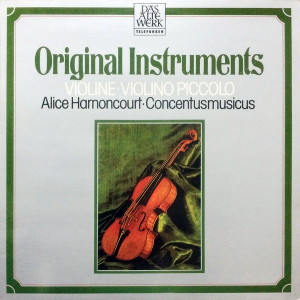 |
1 LP -
Telefunken 6.42623 AP (c) 1981
|
|
ORIGINALINSTRUMENTE - Violine
& Violine piccolo
|
|
|
|
|
|
|
|
| Johann Sebastian
Bach (1685-1750) |
Konzert
für Violine und Orchester E-dur,
BWV 1042 |
|
17' 41" |
|
|
-
Allegro |
8' 16" |
|
A1 |
|
-
Adagio |
6' 30" |
|
A2 |
|
-
Allegro assai
|
2' 55" |
|
A3 |
| Antonio Vivaldi (1678-1741) |
Concerto
B-dur, Op. 8 Nr. 5 "La Tempesta di
Mare", F. I/26 (PV 415) |
|
9' 03" |
|
|
-
Presto |
4' 03" |
|
A4 |
|
-
Largo |
2' 28" |
|
A5 |
|
-
Presto |
2' 26" |
|
A6 |
| Georg Philipp
Telemann (1681-1767) |
Duett
B-dur für Blockflöte und Violino
piccolo - (aus "Der Getreue
Music-Meister") |
|
6' 05" |
|
|
-
Dolce |
1' 25 |
|
B1 |
|
-
Scherzando |
1' 02" |
|
B2 |
|
-
Largo e misurato |
1' 53" |
|
B3 |
|
-
Vivace e staccato |
1' 45" |
|
B4 |
| Johann Joseph Fux (1660-1741) |
Rondeau
à 7 für Violino piccolo, Fagott,
Violine, 3 Violen und B.c. -
(aus "Concentus musico
instrumentalis..., 1701") |
|
4' 15" |
B5 |
| Heinrich Ignaz Franz
Biber (1644-1704) |
Sonata
Violino Solo representativa -
Representatio Avium für Violine
und B.c. |
|
10' 45" |
B6 |
|
-
Allegro · Nachtigal · Cu cu · Fresch
· Adagio · die Henn · der Han ·
Presto · die Wachtel · die Katz ·
Musquetir Mars · Allemande
|
|
|
|
| Johann Sebastian Bach |
Aria
für Tenor "Ich traue seiner
Gnaden" - (aus Kantate "In
allen meinen Taten", BWV 97) *
|
|
4' 55" |
B7 |
|
|
|
|
|
| Alice
HARNONCOURT |
|
|
| -
Jacobus Stainer, Absam 1665 |
|
|
| -
Violino piccolo Marian Petz, Wien
1777 |
|
|
|
|
|
| Bach / Vivaldi / Fux /
Biber |
Telemann |
|
| CONCENTUS
MUSICUS WIEN |
Kees
Boeke, Blockflöte |
|
Kurt
Equiluz, Tenor *
|
|
|
Nikolaus
Harnoncourt, Leitung
|
|
|
|
|
|
|
Luogo
e data di registrazione |
|
Vienna (Austria) -
gennaio 1967 (Bach [Konzert])
Casino Zögernitz, Vienna
(Austria) - ottobre 1976 e marzo
1977 (Vivaldi)
Casino
Zögernitz, Vienna (Austria)
- marzo, giugno e settembre
1969 (Fux)
Casino
Zögernitz, Vienna (Austria)
- marzo e giugno 1969
(Biber)
Casino
Zögernitz, Vienna
(Austria) - febbraio
1978 (Bach [Kantate])
|
|
|
Registrazione:
live / studio |
|
studio |
|
|
Producer
|
|
- |
|
|
Edizione LP |
|
TELEFUNKEN
- 6.42623 AP - (1 LP - durata 52'
44") - (p) 1967 / 1977 / 1978 /
1970 / 1969 / 1979 - Analogico
|
|
|
Originale LP
|
|
TELEFUNKEN - SAWT
9508-A - (1 LP - durata 49' 09")
- (p) 1967 - Analogico (Bach
[Konzert])
TELEFUNKEN - 6.35386 EK - (2
LP's - durata 53' 42" & 52'
26") - (p) 1977 - Analogico
(Vivaldi)
TELEFUNKEN - 6.35451 EK - (2
LP's) - (p) 1978 - Analogico
(Telemann)
TELEFUNKEN - SAWT 9619-A - (1 LP
- durata 47' 35") - (p) 1970 -
Analogico (Fux)
TELEFUNKEN - SAWT 9549-B - (1 LP
- durata 52' 10") - (p) 1969 -
Analogico (Biber)
TELEFUNKEN - 6.35442 EX - (2
LP's - durata 34' 32" & 40'
55") - (p) 1979 - Analogico
(Bach [Kantate])
|
|
|
Prima Edizione CD |
|
TELDEC - 8.41227 ZK
- (1 CD - durata 49' 09") - (c)
1984 - AAD (Bach [Konzert])
TELDEC - 8.42985 ZK - (1 CD -
durata 53' 42") - (c) 1984 - AAD
(Vivaldi)
TELDEC - 8.41271 XH - (1 CD -
durata 47' 35") - (c) 1989 - ADD
(Fux)
TELDEC - 2564-69689-2 - (1 CD -
durata 52' 10") - (c) 2008 - ADD
(Biber)
TELDEC - 8.44280 ZK - (1 CD -
durata 76' 15") - (c) 1989 - ADD
(Bach [Kantate])
|
|
|
Note |
|
Long
playing compilation.
|
|
|
|
|
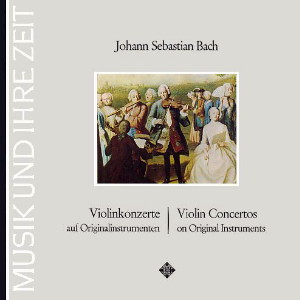 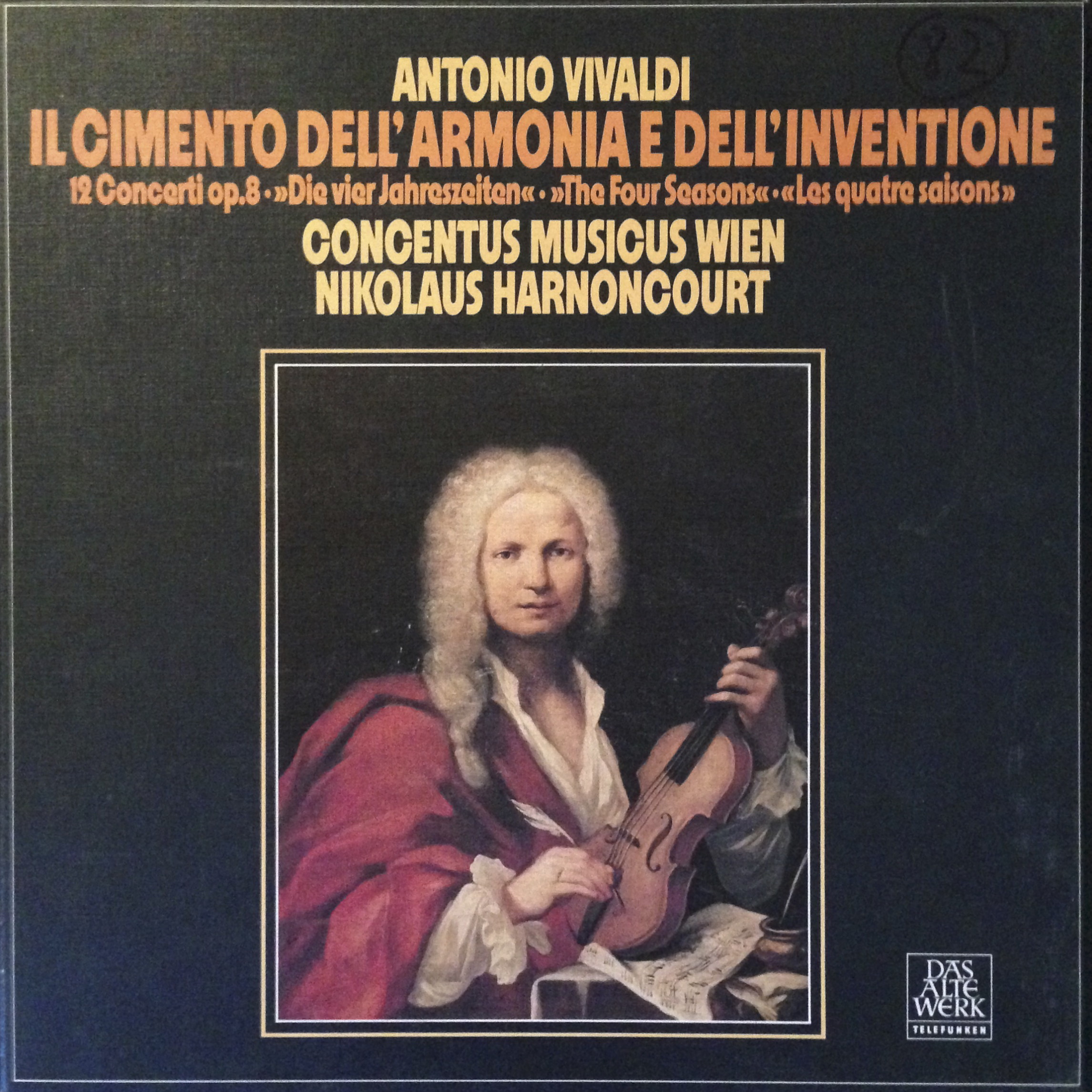 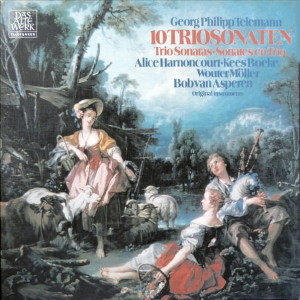 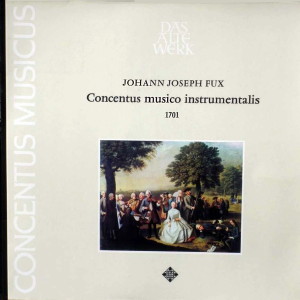 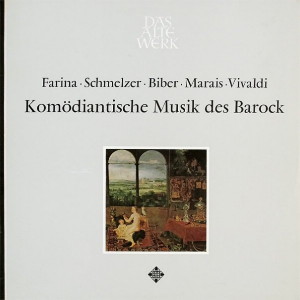 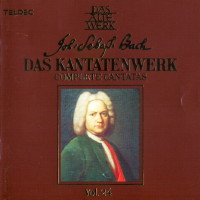 |
Bach's
Concerto in E
major is, in the
relative weight of
its movements,
almost reminiscent
of an
overture-suite. In
the broadly
conceived first
movement the
orchestra carries
the main part of
the musical
substance, whereas
the solo is always
of a dreamily
improvisatory
character. The
Adagio cadenza of
this movement is
composed without a
bass; the chords
otherwise played
here are from the
harpsichord
version of the
concerto. There
they make sense,
since such a
melody in a single
part sounds
senseless on the
harpsichord, a
choral instrument;
on the violin the
empty, completely
free descent
particularly
underlines the
spontaneous,
improvisatory
character of this
part - The slow
movement is
constructed on an
ostinato bass.
Here the soloist
has the
opportunity, as
already in the
first movement,
for baroque rubato
playing. In the
accompanying
string parts Bach
uses the then
popular effect of
the bow tremolo or
bow vibrato. These
weightly movements
are followed by a
light Rondo, in
the episodes of
which the solo
part leads ever
new
transformations of
arpeggio figures
to a turbulent
conclusion.
In Vivaldi's "La
tempesta di Mare"
the stormy sea is
painted with its
huge wawes rolling
in from afar,
building up with
increasing
closeness and
continously, so to
speak
syncoptically,
with foam-covered
tips tumbling over
each other (as
from bar 53), ever
closer and higher
(as from bar 61).
- The description
is evidently
intended to be
continued in the
second movement.
At first a
calmness, a
general smoothing
of the wawes,
whose fading
movement, however,
can be clearly
heard in the
unison triads of
the tutti. In the
third movement
bizarre
accumulations of
general pauses and
unusually and
cleverly disguised
key changes
provide the
musical daring
announced in the
title of the
overall work.
Telemann's Duet in
B-flat major (No.
4) for two melody
instruments
without
throughbass was
published 1728/29
in the music
journal "Der
Getreue
Music-Meister".
Telemann provided
a choice of three
different scoring
possibilities for
this sonata.
In the Fux Rondeau
à 7 a simple
dance-like theme
(that is played by
all instruments
eleven times with
slight rhythmic
and dynamic
variation) forms a
framework for the
soli and duets of
the violino
piccolo.
Heinrich I. F.
Biber, one of the
most interesting
composers of the
17th century, was
famous throughout
Europe as a
virtuoso of the
violin. In his
"Animal Sonata"
the sounds of the
nightingale, the
cuckoo, the frog,
the hen, the cock,
the quail and the
cat, and strangely
enough a
"Musketeer March"
as well, are all
imitated,
incorporated
within the
framework of a
violin sonata. The
resultung work is
lively, sparkling
and spring like.
In spite of the
light-hearted,
comical nature of
the work Biber saw
nothing out of
place in
dedicating it to
"the greater glory
of God, the Virgin
Mary and Santa
Cecilia."
Obviously in
baroque times even
at an archbishop's
court one's
notions of the
pleasures in the
next world were
firmly based on
the delights of
this one.
|
|
|
|

